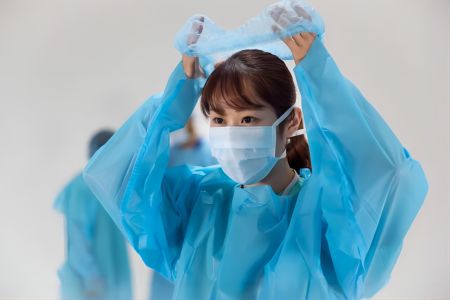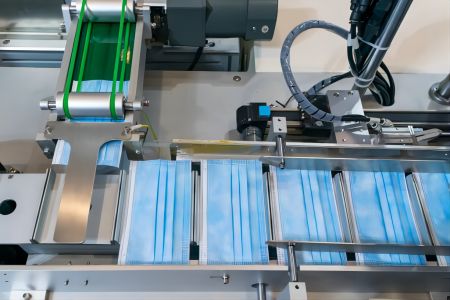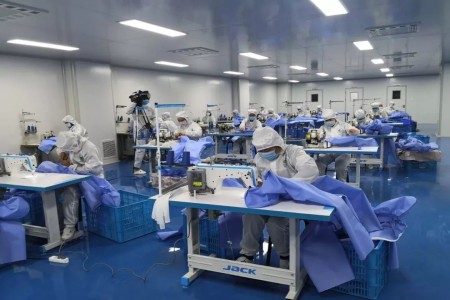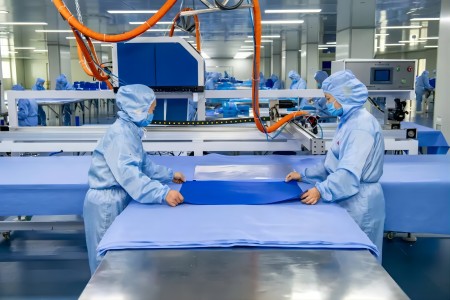2023/6/16

The Essential Guide to Disposable Non-Woven Caps
In environments where cleanliness and contamination control are paramount, a simple piece of attire plays a critical role: the disposable non-woven cap. Also known as hairnets or bouffant caps, these unassuming items are a first line of defense in maintaining hygiene standards across numerous industries.
This article delves into the world of disposable non-woven caps, explaining what they are, why they are used, and the different types available.
What is a Non-Woven Cap?
At its core, a non-woven cap is a single-use head covering designed to contain hair and scalp particles. The term "non-woven" refers to the manufacturing process of the fabric.
Unlike traditional woven textiles (like cotton or polyester) made by interlacing yarns, non-woven fabric is produced by bonding fibers together using mechanical, chemical, or thermal processes. Think of it as the difference between a knitted sweater and a paper towel.
This process results in a fabric that is:
Lightweight and Breathable: Comfortable for extended wear.
Lint-Free: Does not shed fibers, which is crucial in clean environments.
Economical: Designed for single use, reducing laundry costs and cross-contamination risks.
Effective Barrier: Traps loose hair and skin flakes effectively.
Why Are They Used? The Critical Role of Hair Containment
The primary purpose of any disposable hair cap is contamination control. A human being can shed up to 100 hairs a day, along with countless microscopic skin particles. In many settings, this natural shedding can have serious consequences:
Food Processing & Hospitality: In kitchens, restaurants, and food manufacturing plants, a single hair in food is a major health code violation and a significant consumer complaint. These caps prevent physical and biological contamination.
Healthcare & Pharmaceuticals: In hospitals, clinics, and labs, caps help maintain a sterile field, protecting both patients and healthcare workers. In pharmaceutical manufacturing, they are essential for preventing particulate contamination of drugs and medical devices.
Cleanrooms & Electronics Manufacturing: In industries like semiconductor or aerospace manufacturing, even microscopic dust particles can ruin sensitive electronic components. Non-woven caps are a key part of the "bunny suit" ensemble.
Salons & Spas: Used to protect hair color or treatments, or to maintain hygiene during certain services.
A Closer Look at the Different Types
While all non-woven caps serve the same basic function, their designs cater to specific needs. The terms you listed—bouffant, clip cap, strip cap—refer to these design variations.
1. Disposable Non-Woven Bouffant Cap
This is the most common and recognizable type. It's characterized by its full, puffy design with an elasticated band that stretches to fit securely around the entire head.
Key Features: Ample room to accommodate large amounts of hair or even be worn over a beard cover. Excellent all-around coverage.
Best For: General use in food service, healthcare, and manufacturing where full head and hair containment is required.
2. Disposable Non-Woven Clip Cap (or Mob Cap)
Similar to the bouffant cap but often made of a lighter material and featuring a thin, adjustable elastic band that can be "clipped" or tied to size. It has a more gathered, "mob" style appearance.
Key Features: Very lightweight and comfortable. The adjustable tie allows for a customizable fit.
Best For: Situations where comfort for long periods is key, and where the full volume of a bouffant isn't necessary.
3. Disposable Non-Woven Strip Cap
This is a simpler, more minimalist design. It consists of a narrow strip of non-woven fabric with an elastic band, designed to cover just the hairline and the top of the head.
Key Features: Minimalist design, uses less material, and is extremely lightweight.
Best For: Environments with minimal contamination risk where a full bouffant is considered overkill, or for visitors entering a controlled area for a short time.
4. Disposable Non-Woven Hair Cap / Head Cap
These are general terms that are often used interchangeably with "bouffant cap." However, "hair cap" can sometimes refer to a smaller, tighter-fitting style, similar to a traditional hairnet but made from non-woven material instead of mesh.
Key Features: Tighter fit, less volume than a bouffant.
Best For: Individuals with very short or fine hair who do not need the full coverage of a bouffant.
Key Features to Consider When Choosing a Cap
Material: Most are made from Spunbond-Meltblown-Spunbond (SMS) polypropylene, which offers a great balance of comfort, barrier protection, and strength.
Elastic Band: A soft, latex-free elastic is essential for comfort, especially during long shifts, and to prevent allergic reactions.
Size: Ensure the cap is large enough to contain all hair comfortably. Bouffant caps are typically one-size-fits-most.
Color: Colors often signify a role or department (e.g., white for production, blue for quality control, green for visitors) and help in maintaining organizational standards.
Conclusion
Far from being a simple accessory, the disposable non-woven cap is a vital tool in the global effort to ensure safety, quality, and hygiene. By understanding the different types available—from the full-coverage bouffant cap to the minimalist strip cap—businesses can select the right level of protection for their specific needs, safeguarding their products, their processes, and ultimately, their customers.




 WhatsApp
WhatsApp
Send us your message
You can send an email asking for the price and detailed information of this product. We will reply you as soon as we receive your email